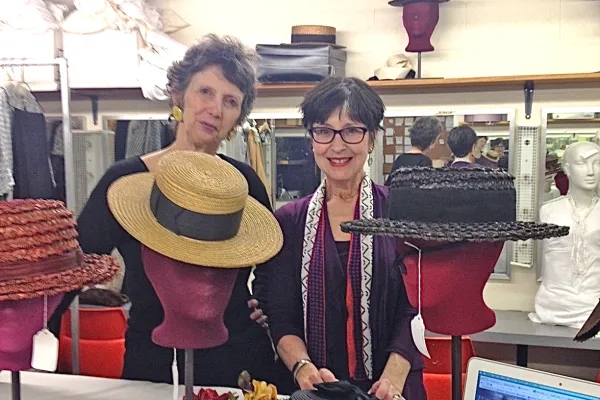Historic Dress Project Creates Online ‘Home’ for Scholarship on Women’s Clothing
Research & Inquiry

Published July 2, 2015
One day last semester, Antonia DaSilva ’18 and Professor of Theatre Kiki Smith ’71 were examining a bolt of printed feedsack cloth spread over a table in the costume room at Mendenhall Center for the Performing Arts.
During the Great Depression, women often sewed canvas or linen feed sacks together to make dresses, said DaSilva, who was preparing a presentation on the topic for the annual Collaborations showcase of student and faculty research.
“I’ve seen feedsack dresses on Etsy but I’d never heard the history before,” DaSilva said, as she smoothed out the cloth. “These didn’t start out pretty, but people began reusing them and producing patterns. A typical dress took three sacks.”
In Smith’s experience, clothing items from the past can be powerful teaching tools.
“They’re a primary source for what women aspired to look like in a particular era,” Smith said. “They’re a gauge—a reflection of women’s lives.”
Sharing such reflections is the idea behind Historic Dress, a Five College Digital Humanities project that Smith helped create. Smith and Elisa Lanzi, director of digital strategies and services for Smith College libraries, are leading the effort to establish a virtual center for teaching and learning about clothing, costume, fashion and culture.
Historic Dress is designed to be an online “home” where users can access information and images from dress collections around the country—including Smith College’s extensive Historic Clothing Collection. The site also contains blog posts and opportunities for sharing research on how clothing reflects societal values about class and gender.
The grant-funded project, which focuses on American women’s clothing and accessories from 1770 to 1930, aims to be a fully participatory digital library on the subject of historic dress. The project got a boost earlier this spring when Historic Dress received one of three Digital Humanities Awards given by Artstor, a New York-based nonprofit that builds and distributes online resources in the arts, humanities and sciences.
Artstor awarded Historic Dress a five-year subscription to its Shared Shelf digital media system, which will allow the project to more easily upload, catalog, store and share information about historic clothing. For example, Shared Shelf will allow site visitors to examine images of garments from multiple angles. The accompanying blogs and exhibits also provide easy links to oral histories, audio files and other resources on clothing from the past.
Lanzi said the idea for Historic Dress began four or five years ago, when she and Kiki Smith were looking for ways to help people access an impressive clothing archive created by Nancy Rexford, acting director of Historic Northampton.
“We thought, this is a special collection and it really should be online,” Lanzi said.
Lanzi, Rexford and Smith were members of an initial Historic Dress working group that began meeting in 2012.
Marla Miller, professor and director of the public history program at the University of Massachusetts Amherst, was another local working group member. Arden Kirkland, digital project manager in theater at Vassar College, rounded out the team.
What began as a Five College project is now expanding to include other participating institutions, such as Drexel University, Ohio State University and the University of Connecticut.
Lanzi said such outreach goes with the territory. “Digital humanities is always collaborative,” she said. “We’re looking for ways to have this scholarship reach a bigger pool of people.”
The digital tools provided by Artstor will enable Historic Dress to classify clothing items using terms common to libraries and museums, Lanzi said.
Kiki Smith said the project will benefit students, who will learn to use those tools.
“Students have assisted us all the way along” in cataloguing the college’s clothing collection, she noted. “This project is a boon to them because they are learning skills and systems that are in demand at museums, libraries and archives.”
Other Smith faculty members are excited about the possibilities Historic Dress poses for classroom teaching.
Professor of Art Barbara Kellum routinely uses the college’s historic clothing collection in her first-year seminars. For their final projects, students are asked to “juxtapose” objects from the Smith College Museum of Art with objects from other collections—including the clothing collection.
“Having the collection online will be tremendously helpful,” Kellum said. “It will make the juxtapositions much richer.”
Jennifer Hall-Witt, a lecturer in history at Smith, has used the clothing collection in her archives course about women in higher education. For example, her students have examined military uniforms worn by members of the Smith College Relief Unit in World War I and gym uniforms worn by previous generations of Smithies.
Encountering such items “raises a lot of interesting questions,” Hall-Witt said. “Having the collection online will make those images easier to find. It’s a valuable resource.”
Smith Professor of Theatre Kiki Smith ’71 (left) and Elisa Lanzi, director of digital strategies and services for the college libraries, are leaders of Historic Dress, a digital humanities project.